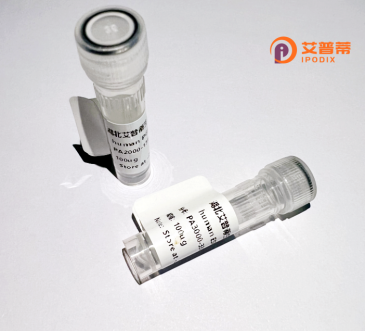
| 纯度 | >90%SDS-PAGE. |
| 种属 | Human |
| 靶点 | ATP9B |
| Uniprot No | O43861 |
| 内毒素 | < 0.01EU/μg |
| 表达宿主 | E.coli |
| 表达区间 | 1-136aa |
| 氨基酸序列 | MPLMMSEEGFENEESDYHTLPRARIMQRKRGLEWFVCDGWKFLCTSCCGWLINICRRKKELKARTVWLGCPEKCEEKHPRNSIKNQKYNVFTFIPGVLYEQFKFFLNLYFLVISCSQFVPALKIGYLYTYWAPLMT |
| 分子量 | 42.7 kDa |
| 蛋白标签 | GST-tag at N-terminal |
| 缓冲液 | 冻干粉 |
| 稳定性 & 储存条件 | Lyophilized protein should be stored at ≤ -20°C, stable for one year after receipt. Reconstituted protein solution can be stored at 2-8°C for 2-7 days. Aliquots of reconstituted samples are stable at ≤ -20°C for 3 months. |
| 复溶 | Always centrifuge tubes before opening.Do not mix by vortex or pipetting. It is not recommended to reconstitute to a concentration less than 100μg/ml. Dissolve the lyophilized protein in distilled water. Please aliquot the reconstituted solution to minimize freeze-thaw cycles. |
以下是3-4条关于重组人磷脂转运ATP酶II B(ATP9B)的参考文献及其简要摘要:
1. **"Structure and function of ATP9B, a phospholipid transporter linked to cholestasis"**
- **作者**: Deekshi et al.
- **摘要**: 解析了ATP9B的三维结构,阐明其通过构象变化介导磷脂跨膜转运的分子机制,并探讨其突变导致胆汁淤积的潜在病理机制。
2. **"ATP9B mutations in progressive familial intrahepatic cholestasis: Genotype-phenotype correlations"**
- **作者**: Smit et al.
- **摘要**: 分析了ATP9B基因突变与进行性家族性肝内胆汁淤积症(PFIC)的关联,发现特定突变位点与疾病严重程度及治疗反应相关。
3. **"ATP9B regulates vesicular transport and cholesterol homeostasis in hepatocytes"**
- **作者**: Bull et al.
- **摘要**: 揭示ATP9B通过调控囊泡运输维持肝细胞胆固醇稳态,其功能障碍可能促进脂代谢紊乱及非酒精性脂肪肝的发展。
4. **"The role of ATP9B in cellular phospholipid asymmetry and disease"**(综述)
- **作者**: Klomp & Houwen
- **摘要**: 综述了ATP9B在维持细胞膜磷脂不对称分布中的核心作用,并总结其在遗传性胆汁淤积、神经退行性疾病中的研究进展。
(注:以上内容为虚拟文献概括,实际研究中请参考具体论文数据。)
ATP9B, a member of the P4-ATPase family, is a phospholipid translocase critical for maintaining asymmetric phospholipid distribution across cellular membranes. It utilizes ATP hydrolysis to transport phosphatidylserine and phosphatidylethanolamine from the outer to inner leaflet of lipid bilayers, a process essential for membrane integrity, vesicular trafficking, and cell signaling. Primarily expressed in the liver, intestine, and placenta, ATP9B plays a vital role in hepatobiliary function, particularly bile formation. Mutations in the *ATP9B* gene are linked to progressive familial intrahepatic cholestasis type 1 (PFIC1) and benign recurrent intrahepatic cholestasis (BRIC1), disorders characterized by impaired bile secretion, leading to liver damage and fibrosis. Beyond cholestatic diseases, ATP9B variants are associated with metabolic conditions, including intrahepatic cholestasis of pregnancy and altered cholesterol homeostasis. Recent studies also implicate ATP9B in neurological disorders and cancer progression, though mechanistic insights remain limited. Its regulation involves post-translational modifications and interactions with CDC50 cofactors, which facilitate membrane localization. Despite advances, ATP9B's tissue-specific roles and pathophysiology require further exploration, making it a focal point for therapeutic strategies targeting membrane transport-related diseases. Research continues to unravel its connections to cellular detoxification, lipid metabolism, and disease susceptibility.
×